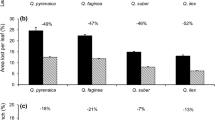Summary
Seasonal occurrence of such wound-induced reaction in birch foliage which deteriorates the quality of nearby leaves for herbivores was tested by means of bioassays. Length of the larval period was protracted in two early and mid-summer (larval period!) lepidopteran species as well as in two mid-summer hymenopteran species when larvae were reared on birch leaves whose adjacent leaves had earlier been damaged mechanically. This response was not found for two late-summer hymenopteran species. In a lepidopteran species whose larval period lasts through the whole season, retardation in growth was significant in the beginning of August but notl later. Hence such response of leaves, interpreted as defensive on the part of the birch, was not efficient after leaves had gained their final size. The potential consequences of wound-induced responses of leaves for herbivores are discussed.
Similar content being viewed by others
Refernces
Benz, G.: Negative Rückkoppelung durch Raum- und Nahrungskonkurrenz sowie zyklishche Veränderung der Nahrungsgrundlage als Regelprinzip in der Populationsdynamik des Grauen Lärchenwicklers, Zeiraphera diniana (Guenée) (Lep., Tortricidae). Z. Ang. Ent. 76, 196–228 (1974)
Haukioja, E., Hakala, T.: Herbivore cycles and periodic outbreaks. Formulation of a general hypothesis. Rep. Kevo Subarctic Res. Stat. 12, 1–9 (1975)
Haukioja, E., Iso-Iivari, L.: Local and annual variation in secondary production by Dineura virididorsata (Hym., Tenthredinidae). Rep. Kevo Subarctic Res. Stat. 13, 26–32 (1976)
Haukioja, E., Niemelä, P.: Does birch defend itself actively against herbivores? Rep. Kevo Subarctic Res. Stat. 13, 44–47 (1976)
Haukioja, E., Niemelä, P.: Retarded growth of a geometrid larva after mechanical damage to leaves of its host tree. Ann. Zool. Fennici 14, 48–52 (1977)
Haukioja, E., Niemelä, P., Iso-Iivari, L.: Birch leaves as a resource for herbivores. II. Diurnal variation in the usability of leaves for Oporinia autumnata and Dineura virididorsata. Rep. Kevo Subarctic Res. Stat. 14, 21–24 (1978a)
Haukioja, E., Niemelä, P., Iso-Iivari, L., Ojala, H., Aro, E.-M.: Birch leaves as a resource for herbivores. I. Variation in the suitability of leaves. Rep. Kevo Subarctic Res. Stat. 14, 5–12 (1978)
Niemelä, P., Aro, E.-M., Haukioja, E.: Birch leaves as a resource for herbivores. Damage-induced increase in leaf phenolics with trypsin-inhibiting effects. Rep. Kevo Subarctic Res. Stat.
Peng, J.H., Black, L.L.: Increased proteinase inhibitor activity in response to infection of resistant tomato plants by Phytophora infestans. Phytopathology 66, 958–963 (1976)
Rhoades, D.F.: Evolution of plant chemical defense against herbivores. In: Interrelationships of secondary plant constituents with herbivores (P.H. Janzen, G.A. Rosenthal, eds.) Academic Press. (in press)
Ryan, C.A., Green, T.R.: Proteinase inhibitors in natural plant protection. In: Recent advances in phytochemistry, Vol. 8, Metabolism and regulation of secondary plant products (V.C. Runeckles, E.E. Conn, eds.), pp. 123–140. New York-London: Academic Press 1974
Author information
Authors and Affiliations
Rights and permissions
About this article
Cite this article
Haukioja, E., Niemelä, P. Birch leaves as a resource for herbivores: Seasonal occurrence of increased resistance in foliage after mechanical damage of adjacent leaves. Oecologia 39, 151–159 (1979). https://doi.org/10.1007/BF00348065
Received:
Issue Date:
DOI: https://doi.org/10.1007/BF00348065




